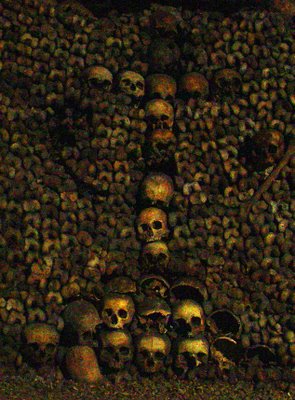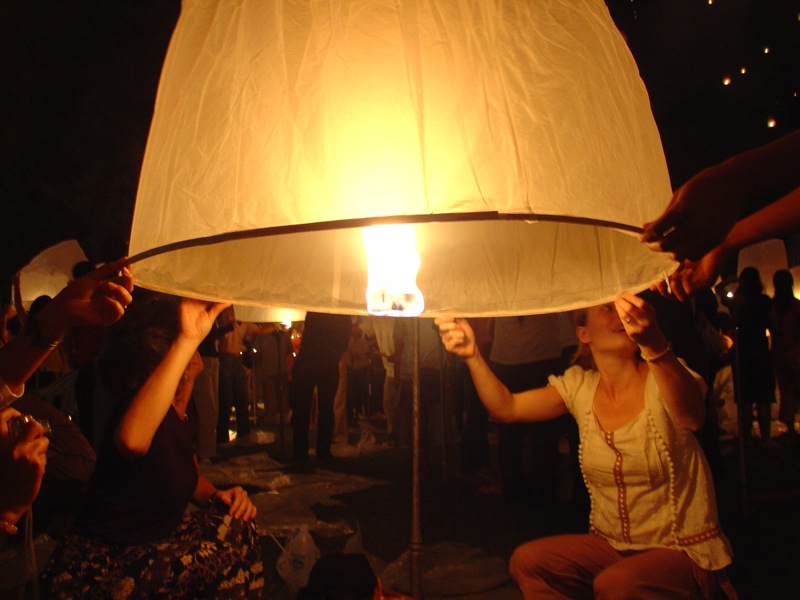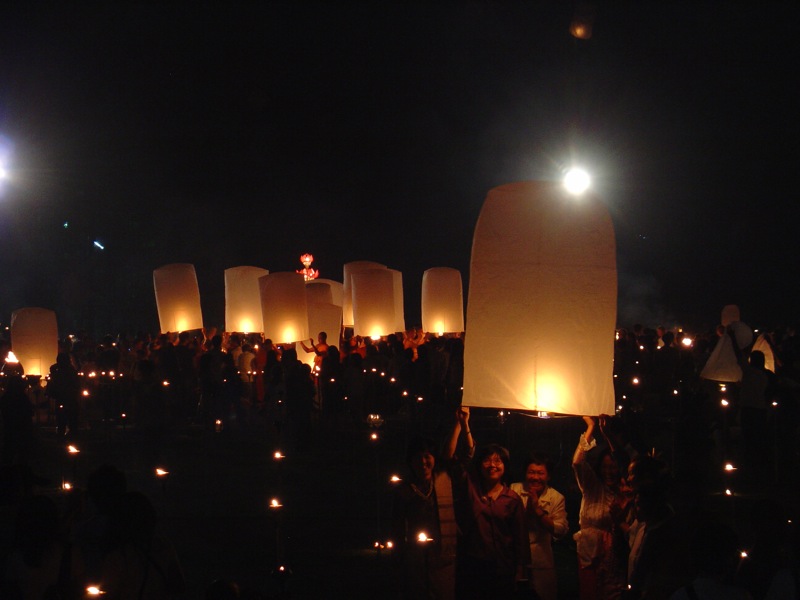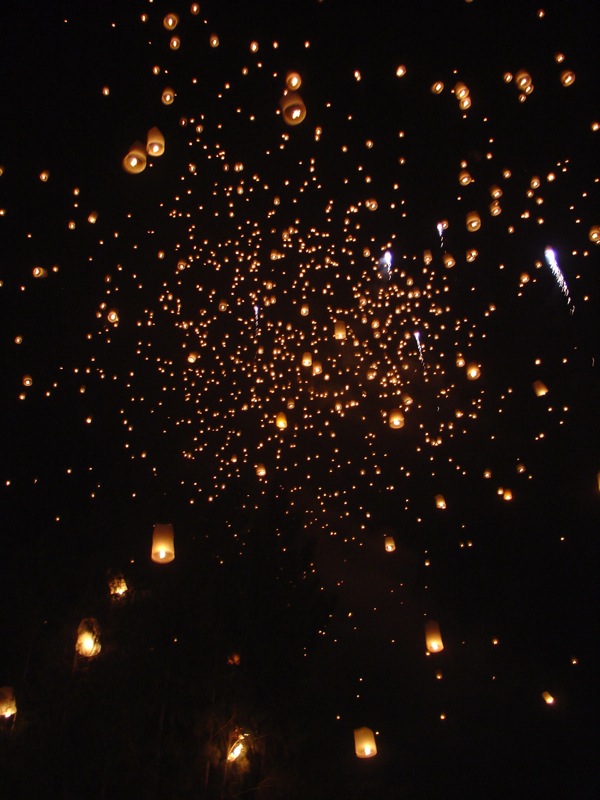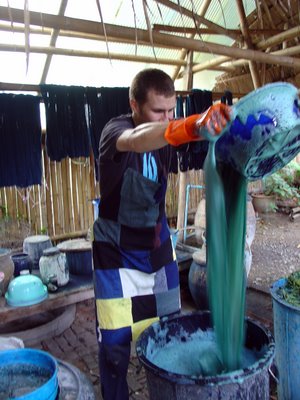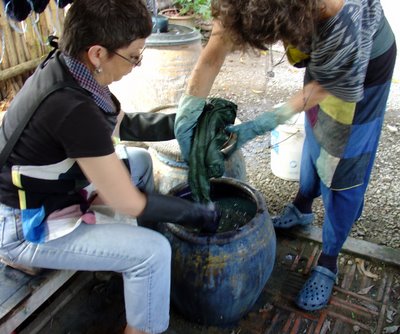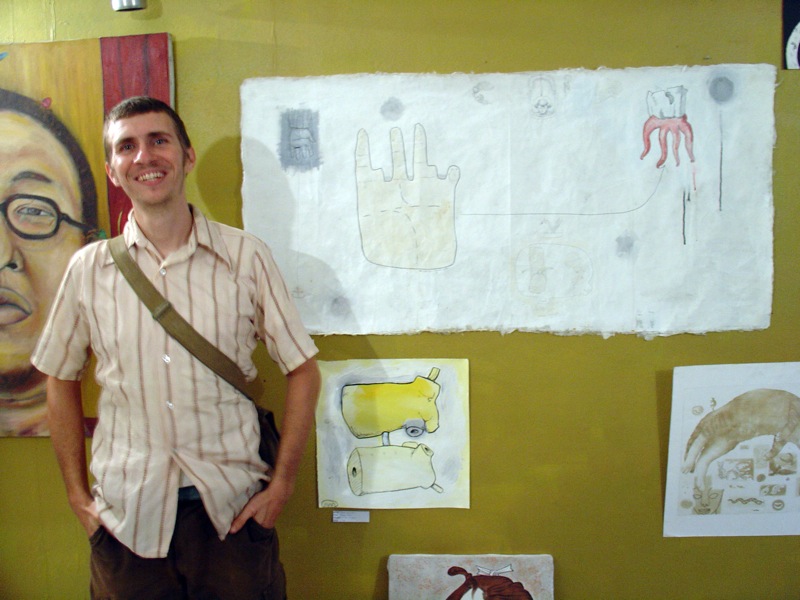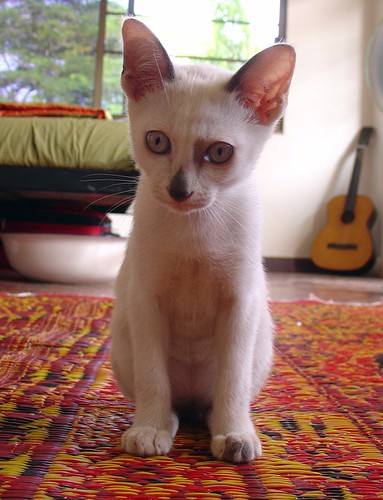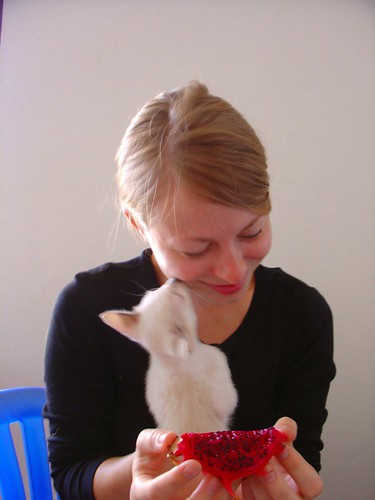31 October 2006
30 October 2006
29 October 2006
Yi Peng
On Saturday while we were eating lunch at The Kitchen (turns out its name in Thaimeans something like "Kitchen Full of Delicious Food") our friend Eh showed up and told us about the Yi Peng festival happening that evening in Mae Jo, just north of town. We'd heard about it, but weren't sure when it happened, so we called up our friend LB, and headed out. Yi Peng means "second moon" in Northern Thai Dialect, meaning that the festival happens on the second month of the Thai lunar year. Or the third. Or the twelfth. I haven't found a reliable source yet. It is the Lanna variant of Loi Krathong, the Thai festival of lights, and involves letting loose thousands of lantern balloons after a day of making merit with the Lord Buddha.
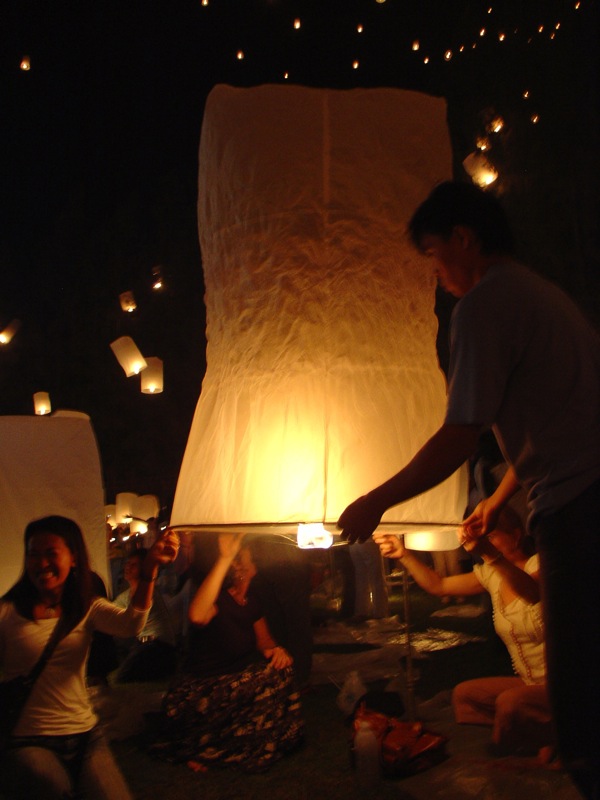
The next day after church we went to Wat Umong to see what the Monk Chat was like. For two hours each Sunday a British monk makes himself available for two hours for people to come and ask him questions. He seemed nice, and sincere, and had some good answers to some pretty dumb questions. There is an abundance of cheap Buddhism here in Thailand. The visit was LB's idea, and she was pretty disappointed. She made a good point about people who grow up with no religious community around them, so they end up searching for anything, and when they find something they don't know when to keep their mouth shut about their personal business.
So we went and looked at the fish pond instead. I was expecting a pond full of carp, but instead it was full of huge plecostomus and catfish, which people were feeding bread and food pellets.
 Plecostomus are algae-eaters, and their mouths aren't adapted to surface feeding. So they make weird behavioral adaptations to compensate, like swimming backwards while pointing up, hoping a pellet will get pulled into their mouth, or pinning a piece of bread to the wall and sucking on it.
Plecostomus are algae-eaters, and their mouths aren't adapted to surface feeding. So they make weird behavioral adaptations to compensate, like swimming backwards while pointing up, hoping a pellet will get pulled into their mouth, or pinning a piece of bread to the wall and sucking on it.Meanwhile, the catfish seem to have no trouble with their huge vacuum cleaner mouths. Almost makes you want to stick your hand in there.
Posted by
Dane
at
6:37 PM
5
comments
![]()
27 October 2006
Indigo Workshop

Ever since I started sewing, I've had an interest in natural dyes. A few weeks ago during the height of indigo season I attended a three day indigo workshop at Studio Naenna. The first day we went out into a neighboring field and cut several wheel barrow loads of indigo. We wrapped the leggy plants into bundles, then carefully filled about 8 garbage cans with 15 kilos worth of bundles and water to cover them. Then we placed a rock on top to keep them from floating up. As the bundles soaked over night the indigo pigment leached out of them, and on day 2 they were ready for "beating." Dane came on the second day to take the place of a sick participant, and we were glad for the extra muscle. In the "beating" process, you incorporate builders lime into the indigo-laced water by scooping and pouring the water back and forth in the can. The process is complete once the water has turned from a light green to a dark blue, and takes about 20 minutes of scooping and pouring!
The workshop instructor didn't let anything go to waste. She had pans to catch every little splash from the beating, and the bundles that we removed from the water previously were dried in the sun to be burned later. The ashes are used to make ash water, the mordant for the dye. After beating the fresh buckets we began to dye our fabrics using an existing dye pot. Good indigo dye pots are maintained in a very delicate balance. Before dying anything, you have to scoop out a cup full of the dye to add back to the pot at the end to replenish the exhausted dye. It's a bit like making yogurt or sourdough bread, with cultures and all. Dane and I dyed handwoven cotton, pictured above, that we purchased from the studio. The fabric is narrow because it's woven on a backstrap loom.

On day 3 we filtered the water that we beat the day before through a tightly woven cloth to collect the indigo paste that settles to the bottom. It's this paste combined with ash water, sugar, an indigo culture, and a little alcohol that makes the dye. In fact, the dye is a dark olive green instead of blue. The fabric turns blue once it hits the air and oxidizes. It's a really amazing process.
Posted by
Jami
at
4:56 AM
0
comments
![]()
Labels: craft, Jami's posts
26 October 2006
Art Walk
Tonight was the Art Walk here in Chiang Mai, organized by AS's friends Laura and Chadwick (once upon a time they lived in Prague and went around to museums, digging up old forgotten paintings from storage, and then painting copies of said paintings onto Chadwick's body). We met up with our friend Dave at Matoom Art Space (where I was showing two drawings), and wandered around to a few of the studios. It was fun, though the highlights may have been finding a stray copy of Art Forum to look at, and talking to Dave about religion. Actually though, there were some prints up at Matoom by a 4th year BFA student named Yong that were pretty nice--apocalyptic and nice. CMU has an exceptional printmaking department, with better facilities and more space than anywhere I've been in the states. We went to the MFA show about two weeks ago and were astounded. CMU offers only one MFA degree, and it's in printmaking. Frankly the most interesting work we've seen here so far has been out of that department.
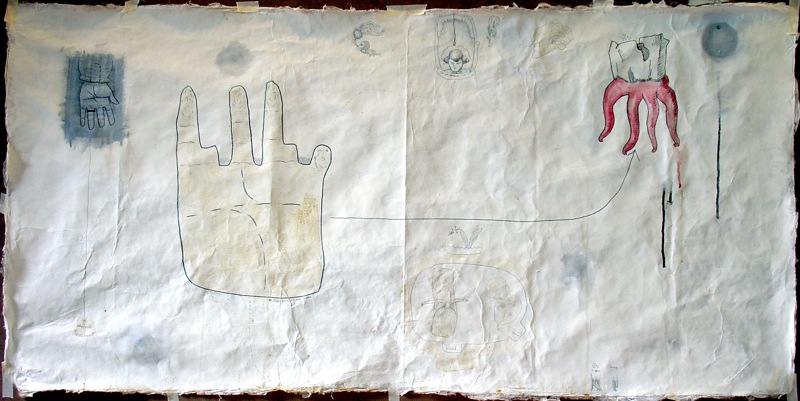 This is one of the drawings I showed, the other can be seen here.
This is one of the drawings I showed, the other can be seen here.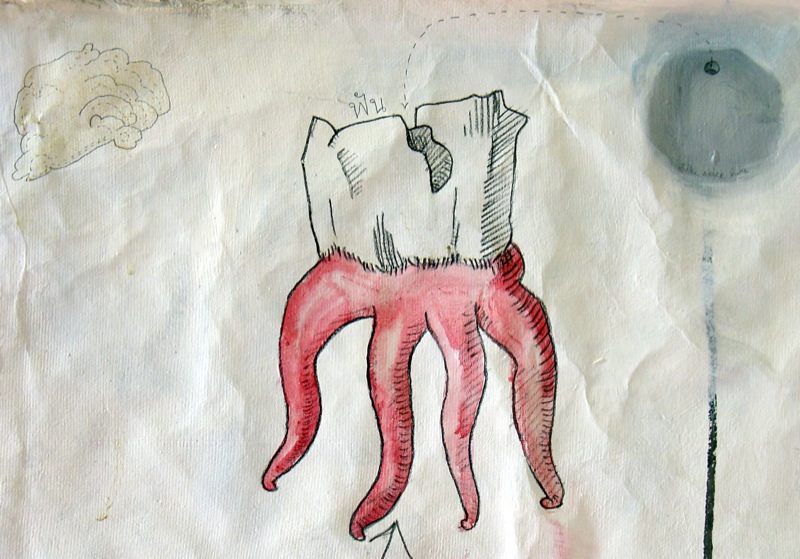 And some details. This was drawn on saa paper, which is made from mulberry bark.
And some details. This was drawn on saa paper, which is made from mulberry bark.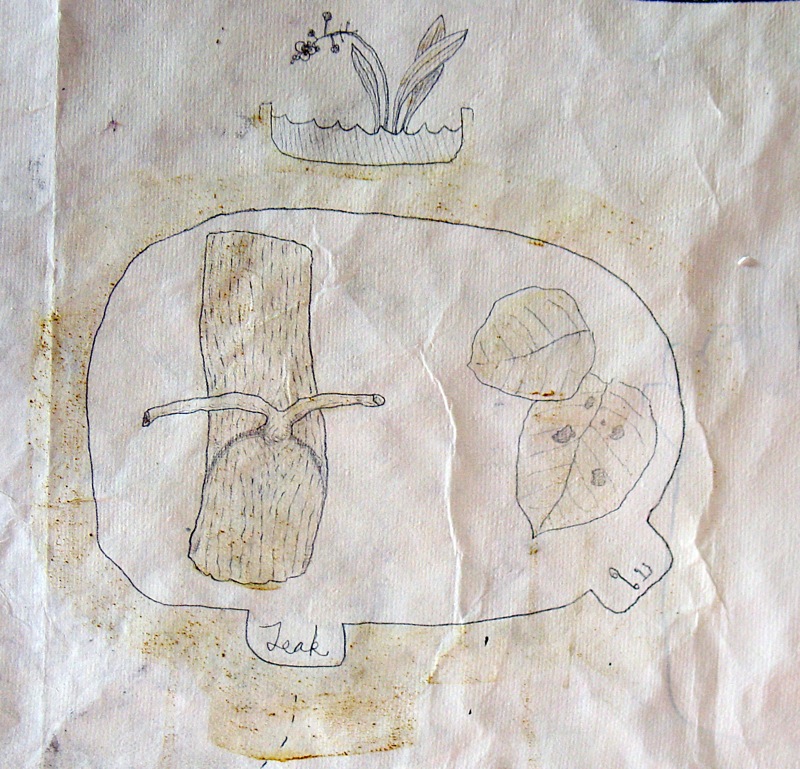 Teak is neat. It has big leaves.
Teak is neat. It has big leaves.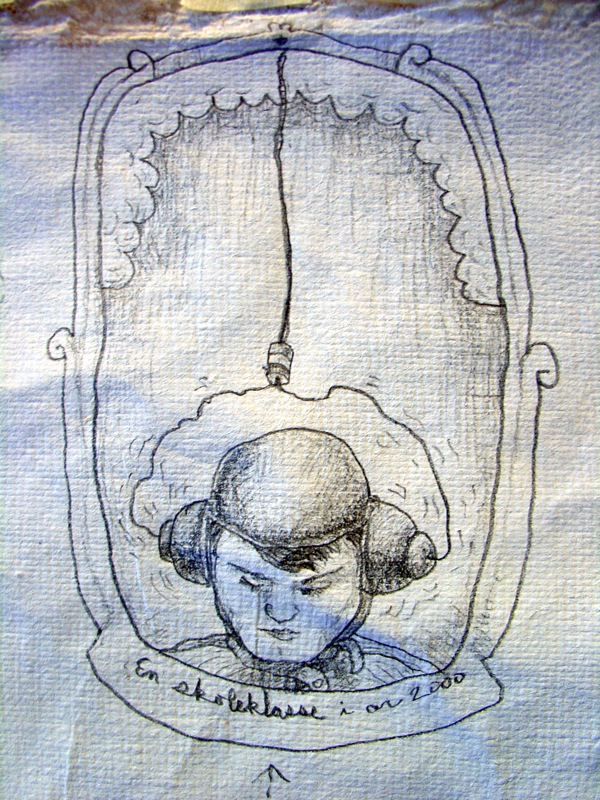 This image was inspired by an etching from a weird Scandinavian encyclopedia we have floating around the house. The tittle says "school in the year 2000" and shows a portly school master tossing books into a glorified meat grinder. The grinder is connected to wires leading to these strange apparati the students wear while seated at their desks. They're about six years too late, but I think Google has this in the works.
This image was inspired by an etching from a weird Scandinavian encyclopedia we have floating around the house. The tittle says "school in the year 2000" and shows a portly school master tossing books into a glorified meat grinder. The grinder is connected to wires leading to these strange apparati the students wear while seated at their desks. They're about six years too late, but I think Google has this in the works.
Posted by
Dane
at
10:49 AM
0
comments
![]()
Labels: art, things you can buy
24 October 2006
I'm Just So Proud
Just today we finally made it to the top hit on Google when you search for "nofolete." I couldn't be happier.
Posted by
Dane
at
10:48 AM
0
comments
![]()
Labels: meta
23 October 2006
A Long Trip, and Two (Minor) Tragedies
On Saturday we took a ride into the mountains. Originally we had planned on visiting Wat Doi Suthep, but we'd already been there. Instead we walked around the market just down the hill from the Wat, looked at the fancy jade shop (no antique pieces, apparently they can't leave the country), and finally saw our first elephant. We left the states thinking there would be elephants everywhere, that there would be elephant parking at the supermarket. Not true. So we were very excited to see this little guy.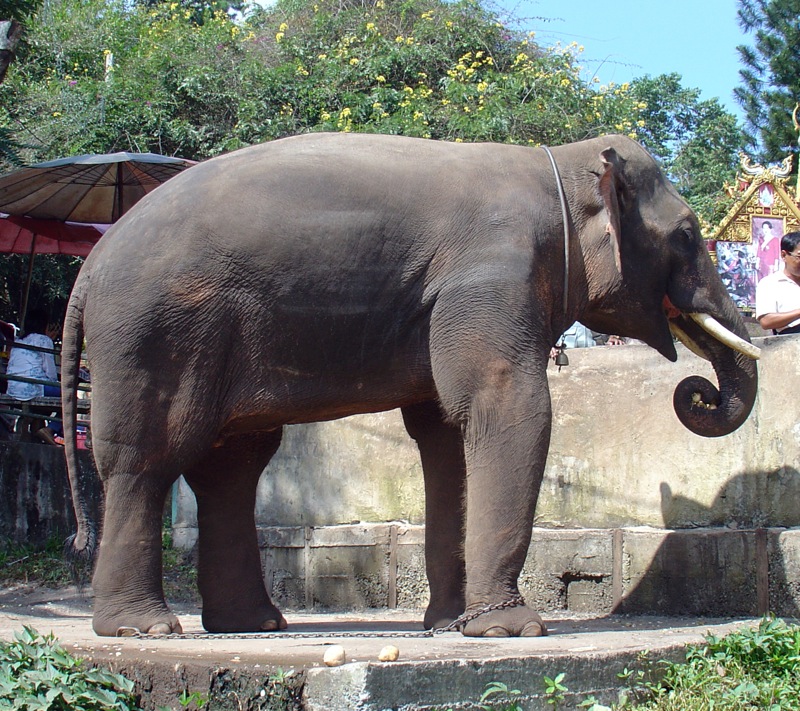
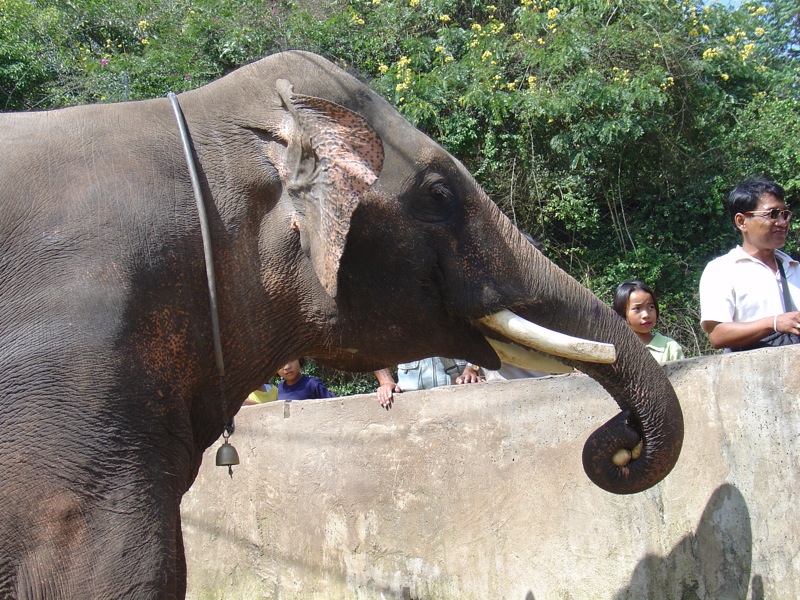 Afterwards we decided to just keep driving up the mountain to see what was there. Our original plan was to go to Wat Doi Pui, but we kind of missed it, and ended up in a Hmong village on the other side of the mountain. We felt very out of place. It's not often that we feel rich. Practically never in fact. But in that village we felt privileged (in a negative sense) and useless. While we were there we admired their stocky little dogs, their corn mill, and I bought a small piece of applique.
Afterwards we decided to just keep driving up the mountain to see what was there. Our original plan was to go to Wat Doi Pui, but we kind of missed it, and ended up in a Hmong village on the other side of the mountain. We felt very out of place. It's not often that we feel rich. Practically never in fact. But in that village we felt privileged (in a negative sense) and useless. While we were there we admired their stocky little dogs, their corn mill, and I bought a small piece of applique.
We used up more than half our tank of gas getting that far out in the mountains, so we coasted all the way back down once we got off of the rutted and muddy unpaved roads.
Back in Chiang Mai, about a block from our house, traffic got bad. So I did what the Thai do and zipped up onto the sidewalk. Dumb idea. A girl stepped out of a phone booth with her back to us, and in my efforts not to hit her the bike fell over and slipped out from underneath me. I scraped my elbow, and Jami, fortunately, landed on top of me. Tragedy number two.
Tragedy number one, which occurred on Friday while I was cutting bamboo in the creek, involved our iPod falling out of my pocket, into the water and getting half buried by silt. When I pulled it out it was still on, but wouldn't turn off (water behind the click wheel). So I took it apart, took out the hard drive, disconnected the battery, and let it dry on the window sill for two days. It still works.
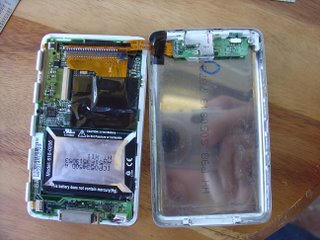 For those of you who have been hankering to tear into one of those little white gumdrops, here's what they look like with the hard drive removed. I'm afraid these two "tragedies" only reinforce my feelings of privilege and uselessness. Maybe I should be grinding corn instead.
For those of you who have been hankering to tear into one of those little white gumdrops, here's what they look like with the hard drive removed. I'm afraid these two "tragedies" only reinforce my feelings of privilege and uselessness. Maybe I should be grinding corn instead.
Posted by
Dane
at
4:08 AM
0
comments
![]()
22 October 2006
Sweet and Sour Cat
Posted by
Jami
at
4:59 AM
1 comments
![]()
Labels: Jami's posts
16 October 2006
"Believe" Lanna Style: Or How Does a Horse Eat a Japanese Ceramicist: Or How to Eat a Bug Sober
Our design workshop began two weeks ago Monday, and ended last Saturday. It was hosted by the Chiang Mai University Faculty of Fine Art Craft and Design Service Center. The real name of the workshop ("Believe" Lanna Style International Workshop) was almost as long as the organization hosting it. Monday morning began with two excellent presentations by Professor Vithi Panitchapun covering Northern Thailand's history, culture, and visual culture (I have both power points saved as PDFs, they really are great, but it might not be that nice of me to upload them without permission, but if anyone is interested I could send them a copy). After Vithi's presentations he took us around Chiang Mai and Lampang for two days. It reminded us a bit of being in Italy, the tour bus rolling through the green hills, but tropical.
I found out about the workshop the night before it began thanks to our housemate AS. Apparently two designers had canceled, AS had been invited by a friend to participate, but decided that producing two prototypes in two weeks might not be his cup of tea. So he passed the buck to me (Jami and I both thank him for that), and I agreed to do it, not really knowing what I'd be getting into. Jami came with me the first day, just for the lecture, and since they were still one person shy of a quorum they begged her to join.
Day One:
 We visited many, many wats in Chiang Mai that first day. This was a small one in a larger compound near the center of town.
We visited many, many wats in Chiang Mai that first day. This was a small one in a larger compound near the center of town. There are many different "brands" of singha (temple dogs) according to Vithi. This nifty feller with the pageboy hairdo is pretty unique.
There are many different "brands" of singha (temple dogs) according to Vithi. This nifty feller with the pageboy hairdo is pretty unique.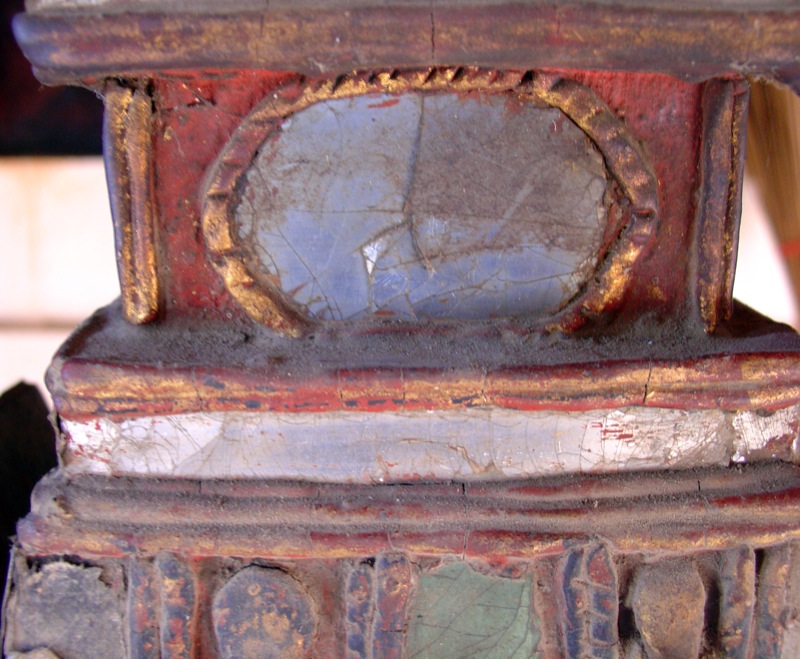 This crackly glass is a unique, lead-backed type. It can actually be cut with scissors. The art of making it has been lost, however. So people strip it from the old wats, sell it by the kilo, and replace it with crummy colored mirror.
This crackly glass is a unique, lead-backed type. It can actually be cut with scissors. The art of making it has been lost, however. So people strip it from the old wats, sell it by the kilo, and replace it with crummy colored mirror.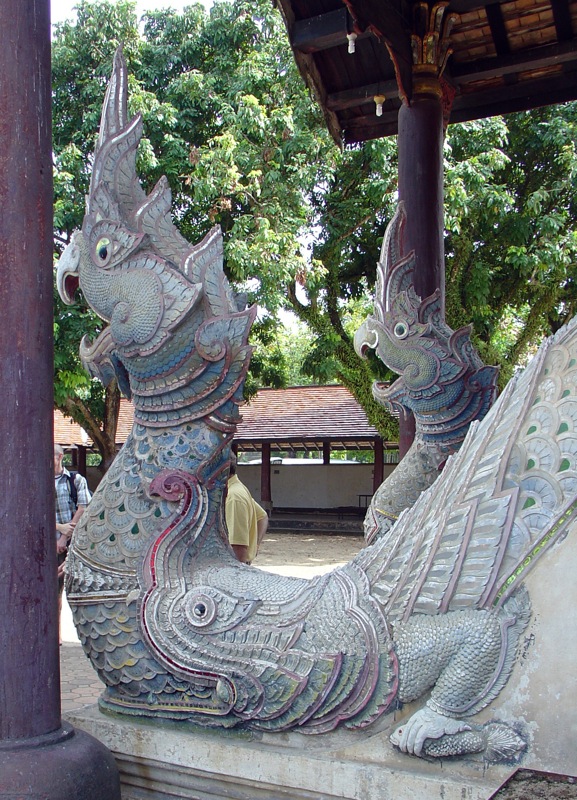 This water-serpent naga with a mouthful of parrot-head naga is pretty typical of Thai Buddhist iconography. It is referred to as "klean mai khaw, klay mai oak," or "cannot swallow, cannot spit out." Situated at the foot of the steps leading to the entrance of a wat this creates a powerful linimal zone, where one can either continue on towards enlightenment, or back to the world, or neither, as one becomes entangled in a visual and spiritual aporia.
This water-serpent naga with a mouthful of parrot-head naga is pretty typical of Thai Buddhist iconography. It is referred to as "klean mai khaw, klay mai oak," or "cannot swallow, cannot spit out." Situated at the foot of the steps leading to the entrance of a wat this creates a powerful linimal zone, where one can either continue on towards enlightenment, or back to the world, or neither, as one becomes entangled in a visual and spiritual aporia.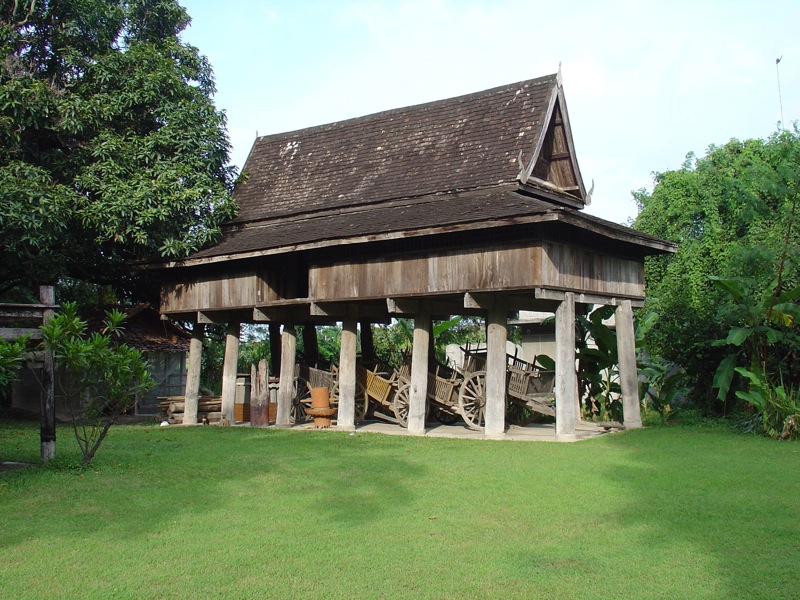 A fine rice house, used only for storage. The form is a lot like granaries from as far away as Portugal. There is a Lanna folk tradition, that as a boy went out to search for a girl to marry (Lanna culture is matrilineal, so the boy marries into the girl's family) he wanted to find a family with a rice house with more than six post (too few and he would starve, not enough rice), and less than fourteen (too many and he would have to work harder that a water buffalo). This one is on the large side.
A fine rice house, used only for storage. The form is a lot like granaries from as far away as Portugal. There is a Lanna folk tradition, that as a boy went out to search for a girl to marry (Lanna culture is matrilineal, so the boy marries into the girl's family) he wanted to find a family with a rice house with more than six post (too few and he would starve, not enough rice), and less than fourteen (too many and he would have to work harder that a water buffalo). This one is on the large side. Just a little gratuitous anthropophagy. Because nothing tastes quite like people.
Just a little gratuitous anthropophagy. Because nothing tastes quite like people.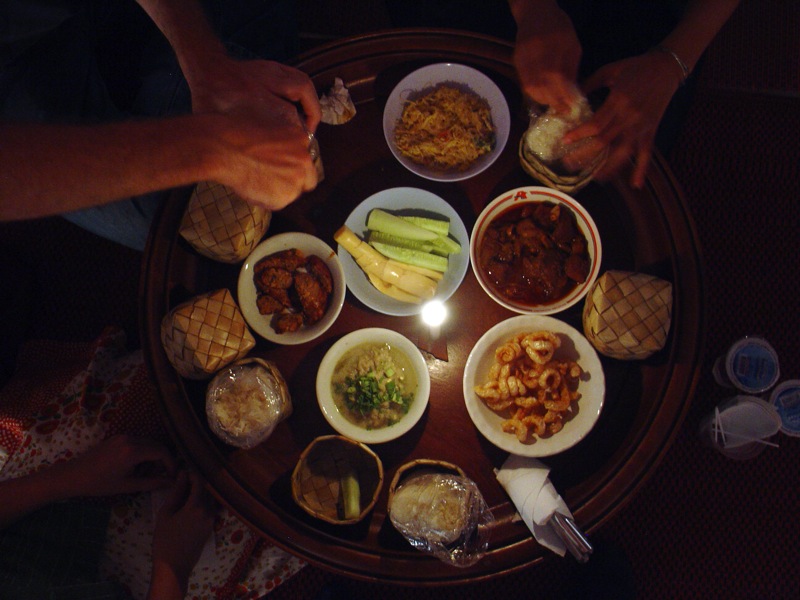 After a full day of lectures and touring we went to the Chiang Mai university campus for an evening of food, music and dance. Northern Thai food is a sight better than people, though I would have eaten that curry no matter what was in it. Maybe that's what the anthropophagi were making.
After a full day of lectures and touring we went to the Chiang Mai university campus for an evening of food, music and dance. Northern Thai food is a sight better than people, though I would have eaten that curry no matter what was in it. Maybe that's what the anthropophagi were making.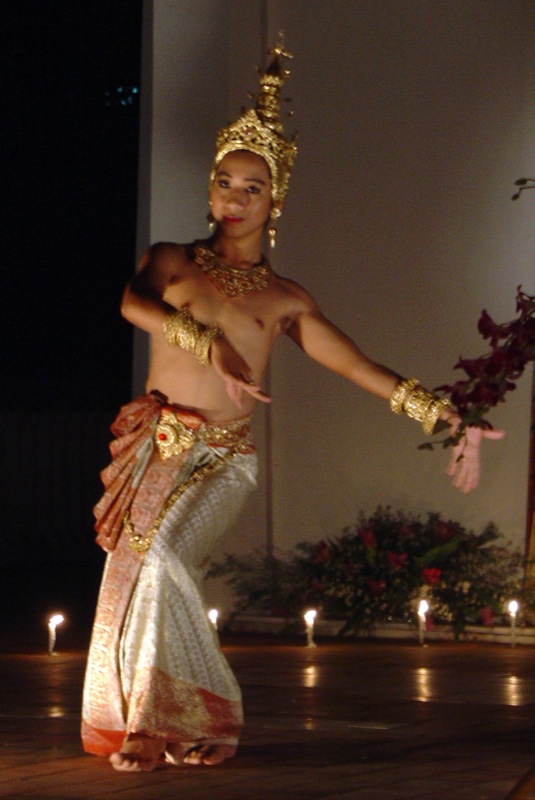 Nice hat?
Nice hat?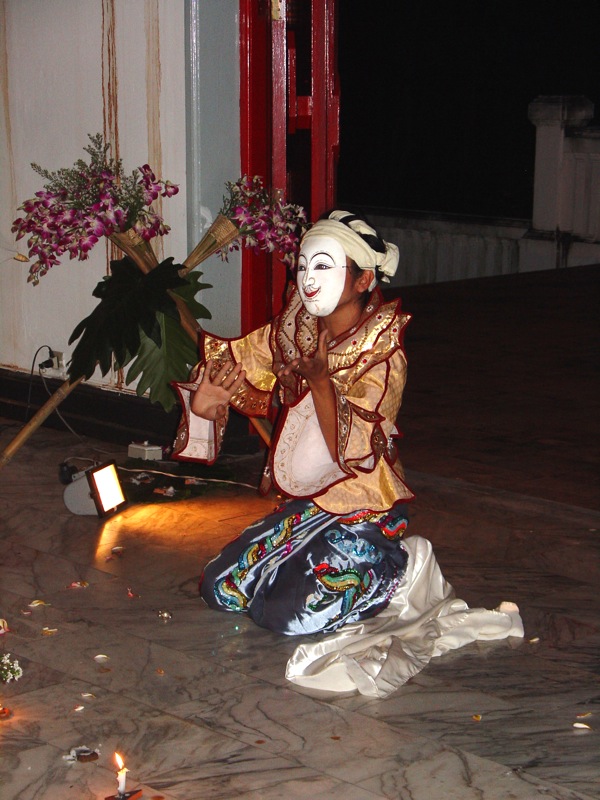 This mask dance was one of our favorites.
This mask dance was one of our favorites.We call this one, informally, the butterfly dance, though it could be of a bird or a bat. We don't know much about traditional Thai dance yet, but we have been told that the different hand positions have different meanings.
Day Two:
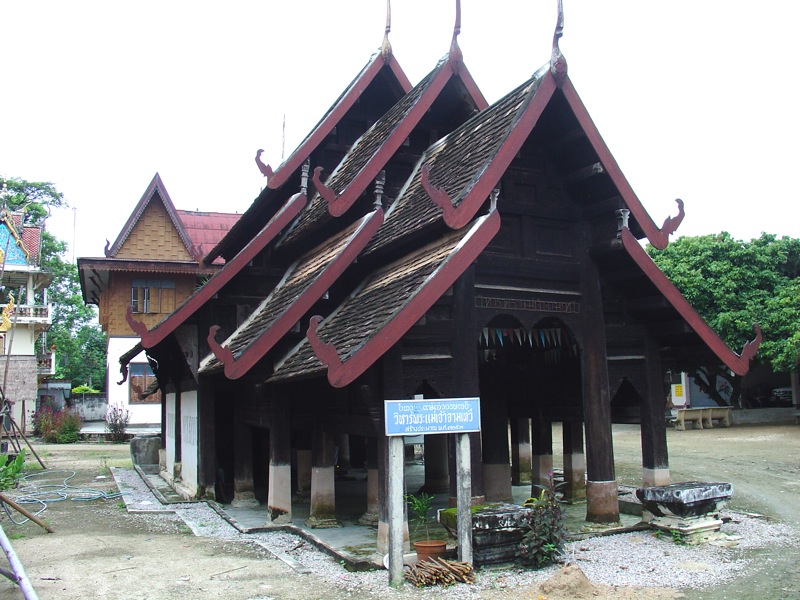 Day two began early with a visit to a tiny little wat outside of Lampang, and it didn't end until about 16 hrs later. Wat Pongyangkok is about three hundred years old. Originally it stood on a platform one meter above the ground, but now it sits about eight inches below. It is unique in that it has retained its open-air form. Normally villagers "restore"their wats by putting brick and stucco walls between the outer posts, and then covering the thing with bits of colored mirror and sheets of gold colored flashing.
Day two began early with a visit to a tiny little wat outside of Lampang, and it didn't end until about 16 hrs later. Wat Pongyangkok is about three hundred years old. Originally it stood on a platform one meter above the ground, but now it sits about eight inches below. It is unique in that it has retained its open-air form. Normally villagers "restore"their wats by putting brick and stucco walls between the outer posts, and then covering the thing with bits of colored mirror and sheets of gold colored flashing.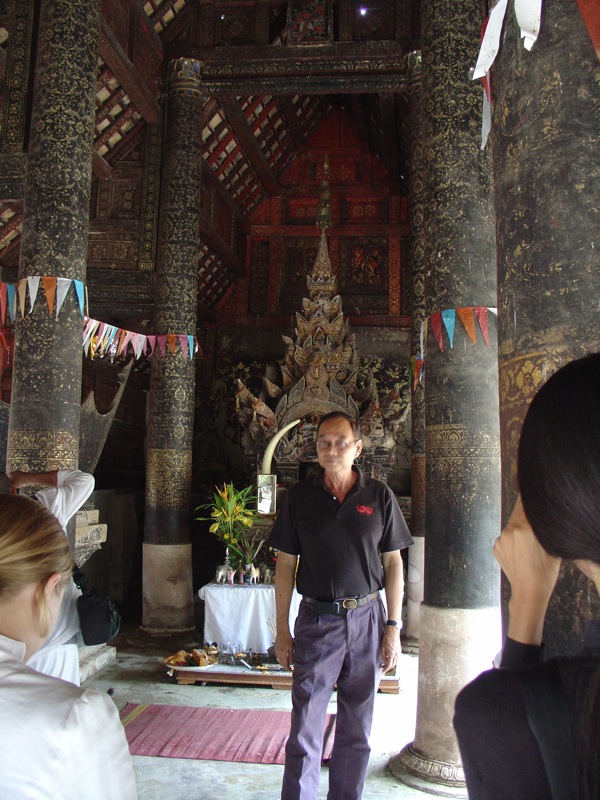 Vithi in the interior of Wat Pongyangkok. Also: the back of Jami's head, and the back of Nok's head.
Vithi in the interior of Wat Pongyangkok. Also: the back of Jami's head, and the back of Nok's head.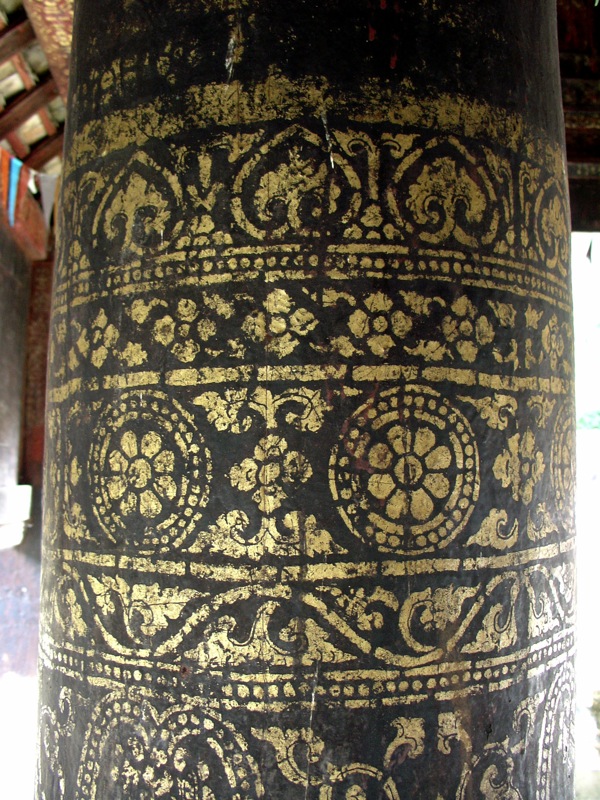 The pillars in Wat Pongyangkok were just amazing. They are covered with lacquer and goldleaf. On our Flickr page you can see how this is done, since they were the inspiration for one of my designs.
The pillars in Wat Pongyangkok were just amazing. They are covered with lacquer and goldleaf. On our Flickr page you can see how this is done, since they were the inspiration for one of my designs. Our next stop, and the last one I'll talk about in any detail, was Wat Phrathat Lampangluang in Lampang. It is an old citadel type wat, esablished 800 year ago, though its current incarnation is 15th century. In the photo you can see a tree inside the walls off to the left (not the palm tree). There is a legend that the Buddha passed through here on his travels. A Luah man (Austro-Asiatic ethnic group) offered him a piece of bamboo full of honey, and he was so happy having met the Buddha that he wandered off without his walking stick, leaving it stuck in the ground. When he came back the walking stick had sprouted, and grown into a tree. However, it had been put in the ground upside down, so the branches sloped downwards instead of up and the leaves were upside down. As legend has it that tree is here.
Our next stop, and the last one I'll talk about in any detail, was Wat Phrathat Lampangluang in Lampang. It is an old citadel type wat, esablished 800 year ago, though its current incarnation is 15th century. In the photo you can see a tree inside the walls off to the left (not the palm tree). There is a legend that the Buddha passed through here on his travels. A Luah man (Austro-Asiatic ethnic group) offered him a piece of bamboo full of honey, and he was so happy having met the Buddha that he wandered off without his walking stick, leaving it stuck in the ground. When he came back the walking stick had sprouted, and grown into a tree. However, it had been put in the ground upside down, so the branches sloped downwards instead of up and the leaves were upside down. As legend has it that tree is here. So how does a horse eat a Japanese Ceramicist? He sniffs along, sniffs along, takes a little bite. Sniffs along, sniffs along, takes a bigger bite. Sniffs along, sniffs along...
So how does a horse eat a Japanese Ceramicist? He sniffs along, sniffs along, takes a little bite. Sniffs along, sniffs along, takes a bigger bite. Sniffs along, sniffs along...Masamichi Yoshiakawa was one of the artists participating in this workshop (he and his wife Chikako). He thought it might be neat to pet this little pony, which promptly took a chunk out of his arm. In this photo here, you can see a blurry Masamichi with his sleeve rolled up to keep it out of the wound.
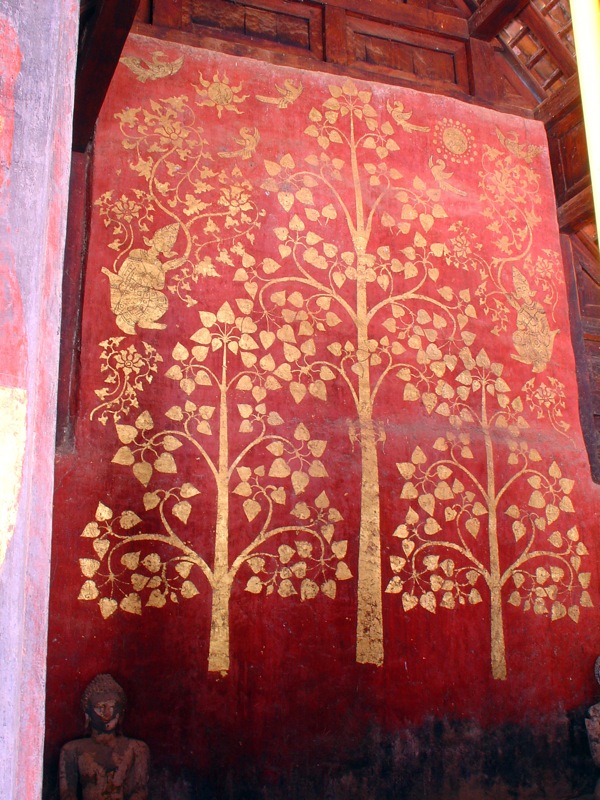 This was a particularly nice bodhi tree. These paintings typically back the Buddha images in the depths of the wat.
This was a particularly nice bodhi tree. These paintings typically back the Buddha images in the depths of the wat.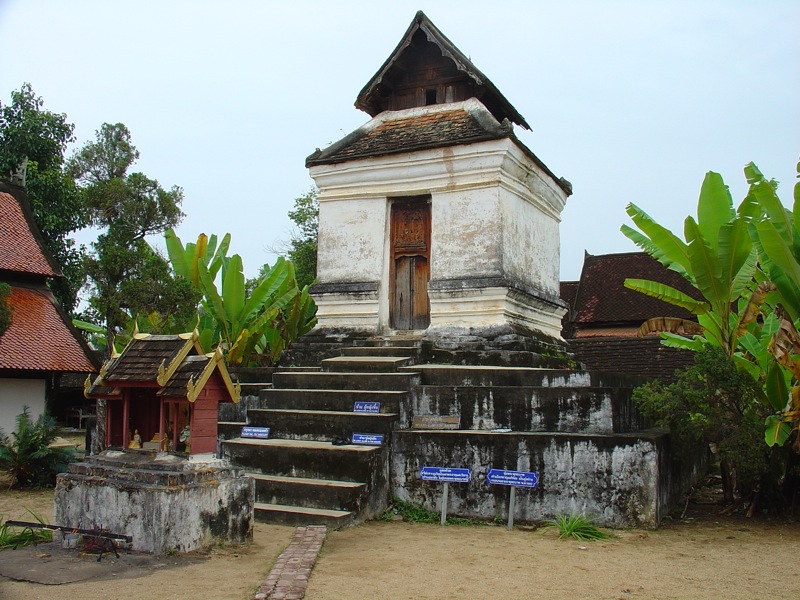 This little shrine at Wat Phrathat Lampangluang is covered with white on blue signs that say "NO GIRLS ALLOWED!"
This little shrine at Wat Phrathat Lampangluang is covered with white on blue signs that say "NO GIRLS ALLOWED!"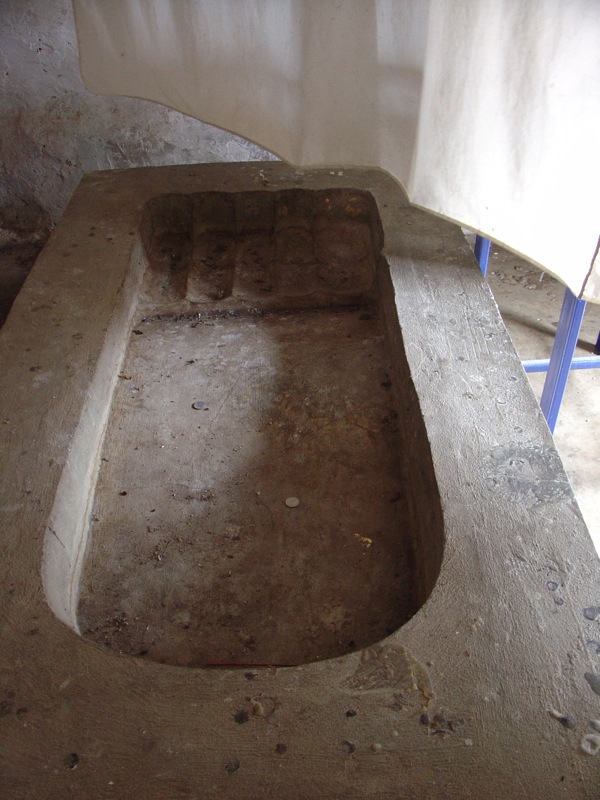 Inside is the footprint of the Buddha, who, even in life, had very large, stylized feet.
Inside is the footprint of the Buddha, who, even in life, had very large, stylized feet. The room also acts as a camera obscura, which allows you to see an image of this stuppa...
The room also acts as a camera obscura, which allows you to see an image of this stuppa...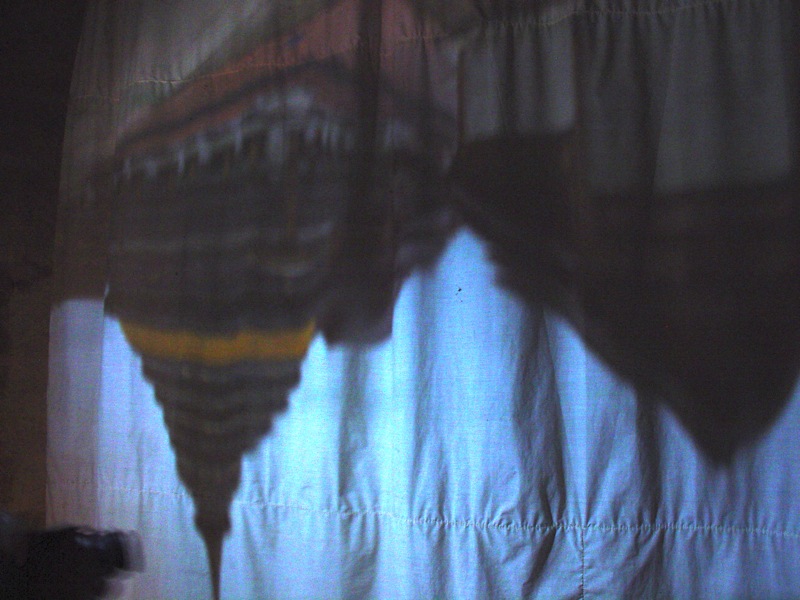 upside down.
upside down.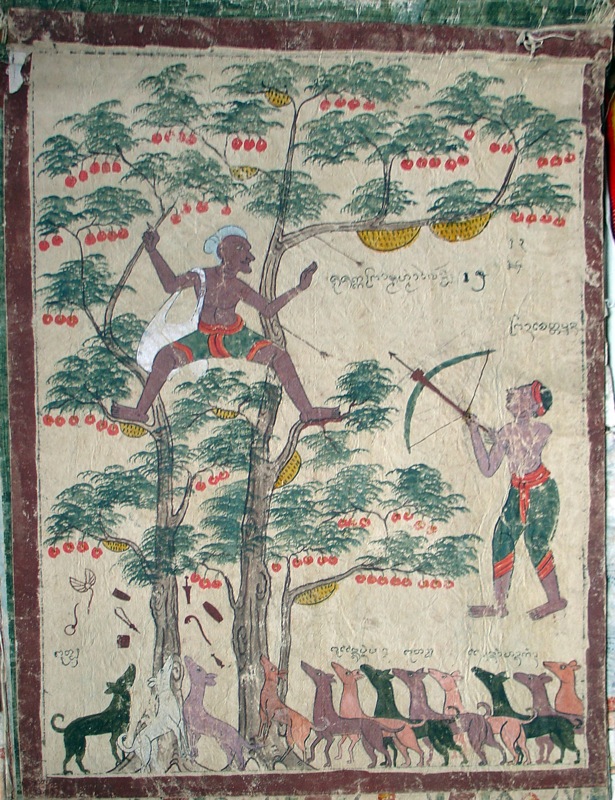 In the afternoon after lunch at Vithi's colonial era house in Lampang he took us to a wat where two large groups of hundred year old paintings had been discovered in the ceiling. This was one of my favorites, with the vagabond treed by a huge pack of dogs, and things dropping from his bag.
In the afternoon after lunch at Vithi's colonial era house in Lampang he took us to a wat where two large groups of hundred year old paintings had been discovered in the ceiling. This was one of my favorites, with the vagabond treed by a huge pack of dogs, and things dropping from his bag. The last wat we visited was fairly recent (about 100 years old), way out in the country and very, very folksy. Jami found this little guy holding up the pulpit, and he was just too cute not to share.
The last wat we visited was fairly recent (about 100 years old), way out in the country and very, very folksy. Jami found this little guy holding up the pulpit, and he was just too cute not to share.Days three through twelve:
These days include our trip to Maesai, Jami's indigo work shop at Studio Naenna (which she will write a post about, I already uploaded a video about it), and lots of work on our projects. We began the workshop not quite sure what we were supposed to be doing (the idea for my first project came suddenly as a complete image about ten minutes before I began talking to my assistant to tell him what materials I'd need), and it wasn't made clear to us that we actually needed to make two prototypes until Friday.
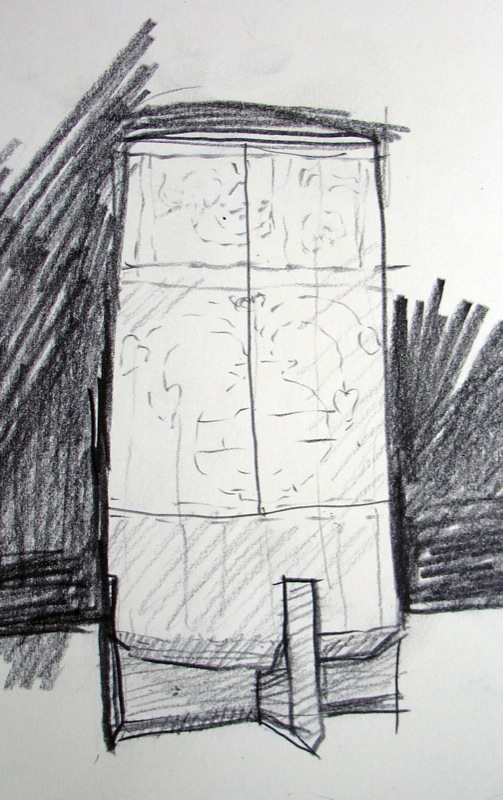 My original idea was to make a section of a column from a temple out of solid teak. A twenty four inch piece of solid teak, eight inches in diameter, proved to be hard to find, and would have been way heavy.
My original idea was to make a section of a column from a temple out of solid teak. A twenty four inch piece of solid teak, eight inches in diameter, proved to be hard to find, and would have been way heavy.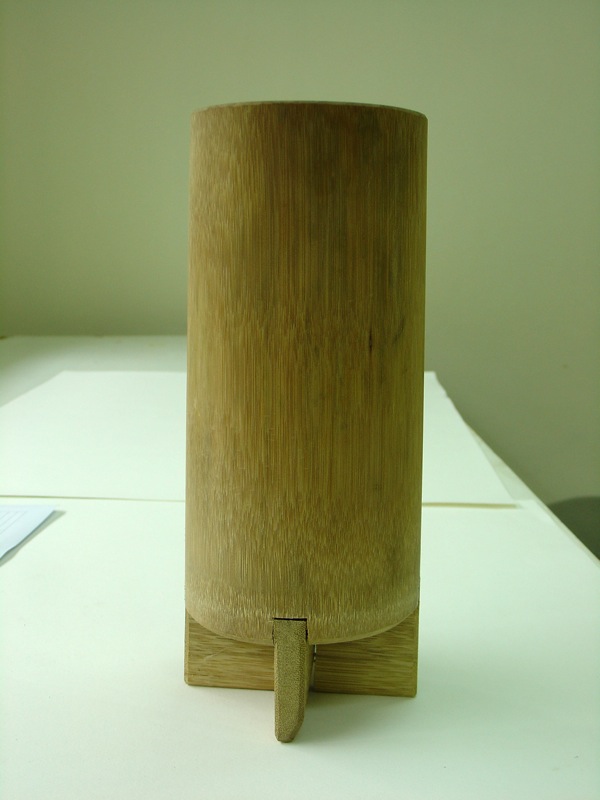 So I settled on bamboo, and turned it into a vessel. The base is inspired by the little feet on sticky rice baskets.
So I settled on bamboo, and turned it into a vessel. The base is inspired by the little feet on sticky rice baskets.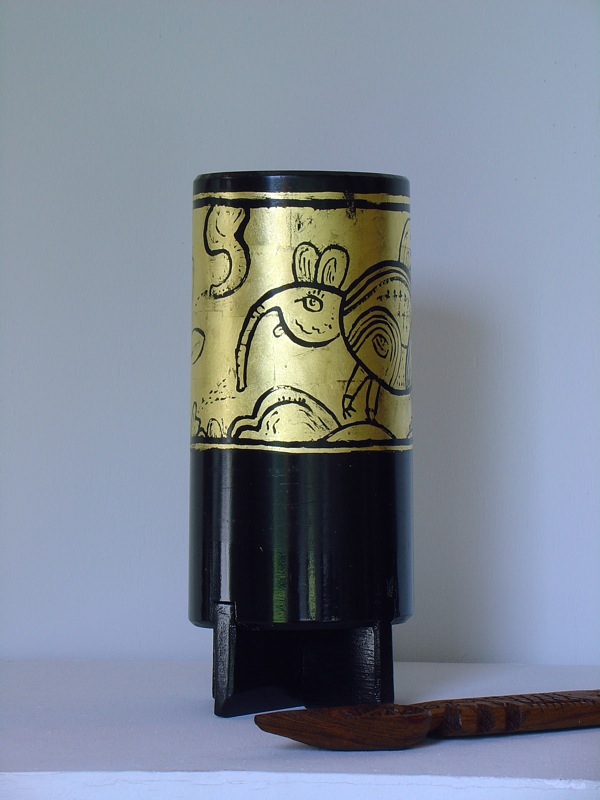 I think it turned out alright. I like the gold leaf on the black lacquer, but I kind of have a thing against precious materials, so I don't know if there will be a repeat (unless someone pays me to it). The part of the wat occupied by the pillars represents the Cosmic Jungle in the Theravada Buddhist cosmology. In our own American secular spiritual tradition (if that's not an oxymoron), i.e. Transcendentalism, we go to the woods to gain enlightenment (or at least you do if you are a genteel resident of Concord, Mass and have the luxury of romanticizing nature). In Therevada Buddhism you have to pass through the woods, then traverse seven rings of mountains, and then climb an even bigger mountain, only to find Siddhartha Gautama already sitting there. So I decided that it would be nice to package a piece of the Cosmic Jungle for export to the west.
I think it turned out alright. I like the gold leaf on the black lacquer, but I kind of have a thing against precious materials, so I don't know if there will be a repeat (unless someone pays me to it). The part of the wat occupied by the pillars represents the Cosmic Jungle in the Theravada Buddhist cosmology. In our own American secular spiritual tradition (if that's not an oxymoron), i.e. Transcendentalism, we go to the woods to gain enlightenment (or at least you do if you are a genteel resident of Concord, Mass and have the luxury of romanticizing nature). In Therevada Buddhism you have to pass through the woods, then traverse seven rings of mountains, and then climb an even bigger mountain, only to find Siddhartha Gautama already sitting there. So I decided that it would be nice to package a piece of the Cosmic Jungle for export to the west.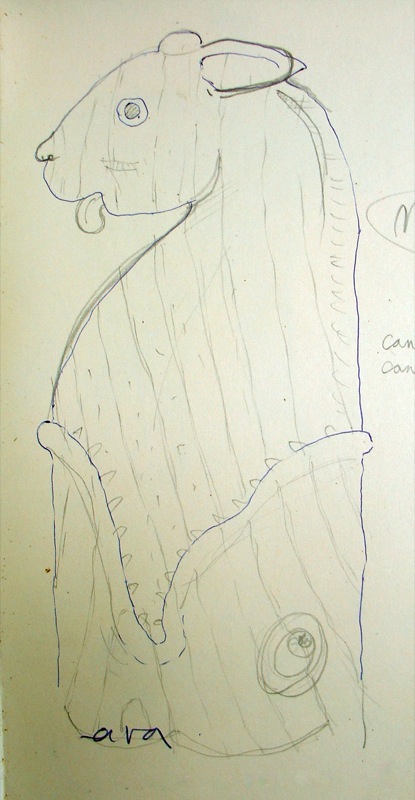 The naga love spoon went through many stages of revision. I even had a completely different piece roughed out before I decided that I hated it (our friend LB might recognize the remains of her name and email address which I erased from the bottom of this drawing. No spam for her).
The naga love spoon went through many stages of revision. I even had a completely different piece roughed out before I decided that I hated it (our friend LB might recognize the remains of her name and email address which I erased from the bottom of this drawing. No spam for her).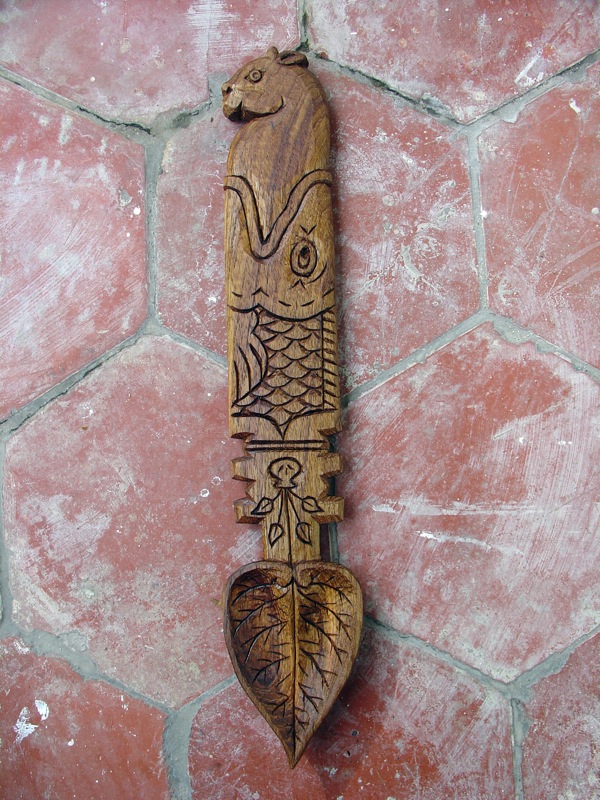 The overwhelming response from the Thai regarding this spoon was, "so cute!" the leaf forming the bowl is, of course, a bodhi leaf.
The overwhelming response from the Thai regarding this spoon was, "so cute!" the leaf forming the bowl is, of course, a bodhi leaf.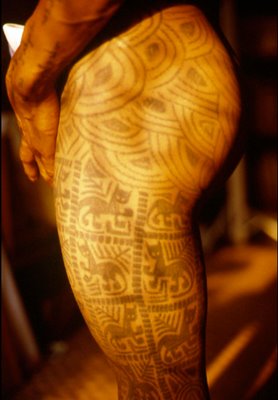 Jami's project involved tattooing male cabaret dancers.
Jami's project involved tattooing male cabaret dancers.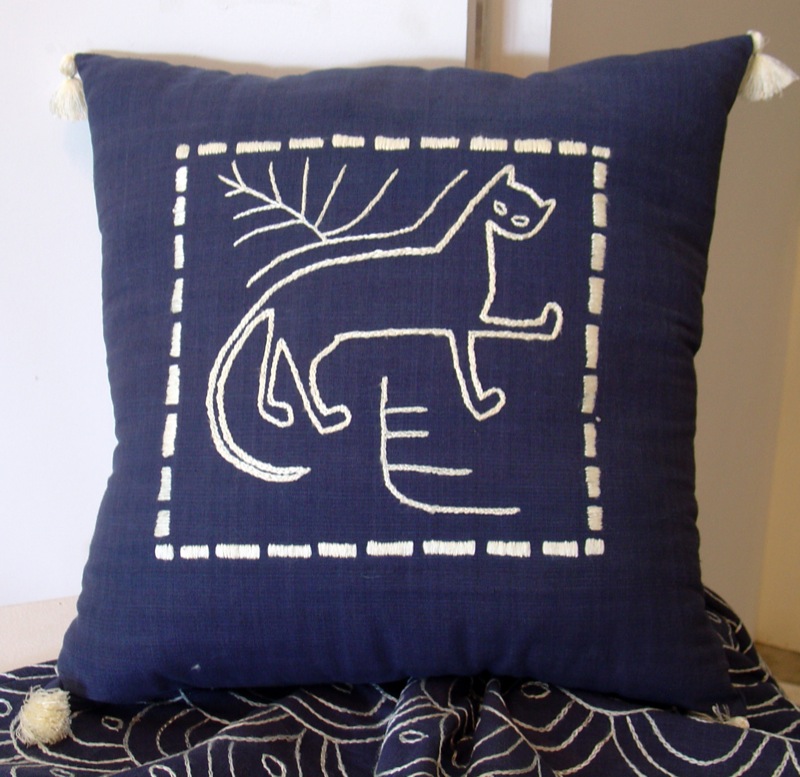 Just kidding. Those are actually traditional leg tattoos worn by Northern Thai men well into the twentieth century. Since boys usually got kicked out of the bedroom out onto the porch to sleep with grandpa around the age of nine, many, as they do today, ended up becoming novitiates at a local wat. Those that decided the life of celibacy was not for them left during their teens and joined a trade caravan, and went looking for a reasonably sized rice house. The leg tattoos were their cultural currency: the fish scale patterns endeared them to potential mother-in-laws on the northern routes up into China, while the cats worked in the southwest and out to the coast, where boats came from Sri Lanka.
Just kidding. Those are actually traditional leg tattoos worn by Northern Thai men well into the twentieth century. Since boys usually got kicked out of the bedroom out onto the porch to sleep with grandpa around the age of nine, many, as they do today, ended up becoming novitiates at a local wat. Those that decided the life of celibacy was not for them left during their teens and joined a trade caravan, and went looking for a reasonably sized rice house. The leg tattoos were their cultural currency: the fish scale patterns endeared them to potential mother-in-laws on the northern routes up into China, while the cats worked in the southwest and out to the coast, where boats came from Sri Lanka.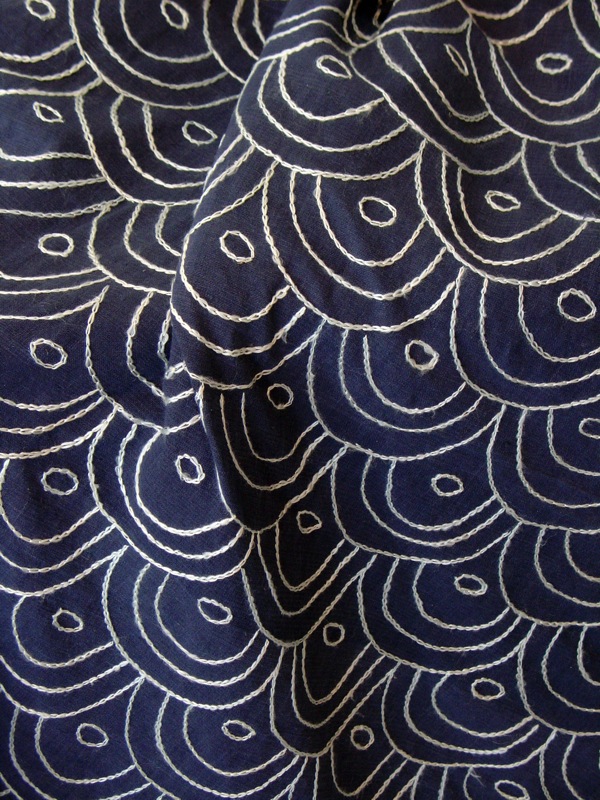 A dedicated team of women from a crafts circle somewhere outside of Chiang Mai helped finish all these fish scales in time.
A dedicated team of women from a crafts circle somewhere outside of Chiang Mai helped finish all these fish scales in time.Day Thirteen:
In the morning all the participants gave brief presentations of their projects and prior work. The westerners went last. I wish everyone had a website for me to refer you to, but the only ones that do are Dave Besseling and Ofer Zick (though if anyone knows of any more I'll happily take corrections). For dinner we headed to a fancy open air restaurant that specializes in Lanna cuisine. And then the fun began.
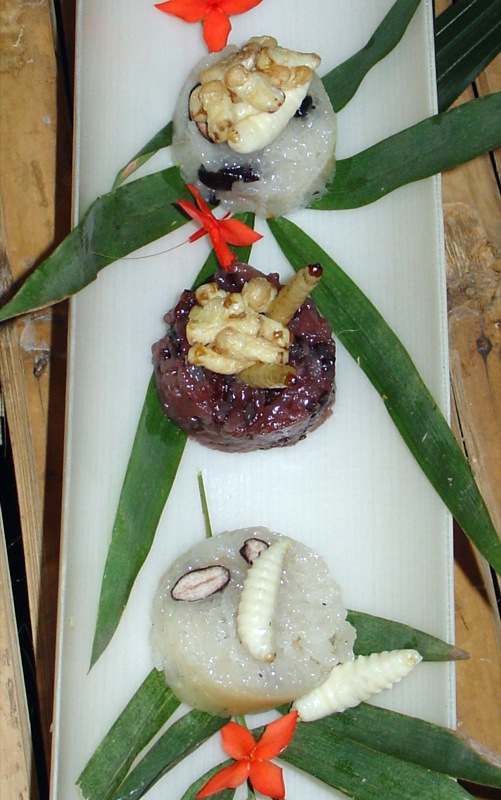 Yes these are what you think they are. Bug hors d'oeuvres. I ate the one on the bottom. It popped, and left a weird film on my teeth, but it tasted OK. To our surprise, no amount of teasing from Ofer and Dave could get the Thai art and design students to try one. Instead they burnt their's to crisps in the candles.
Yes these are what you think they are. Bug hors d'oeuvres. I ate the one on the bottom. It popped, and left a weird film on my teeth, but it tasted OK. To our surprise, no amount of teasing from Ofer and Dave could get the Thai art and design students to try one. Instead they burnt their's to crisps in the candles.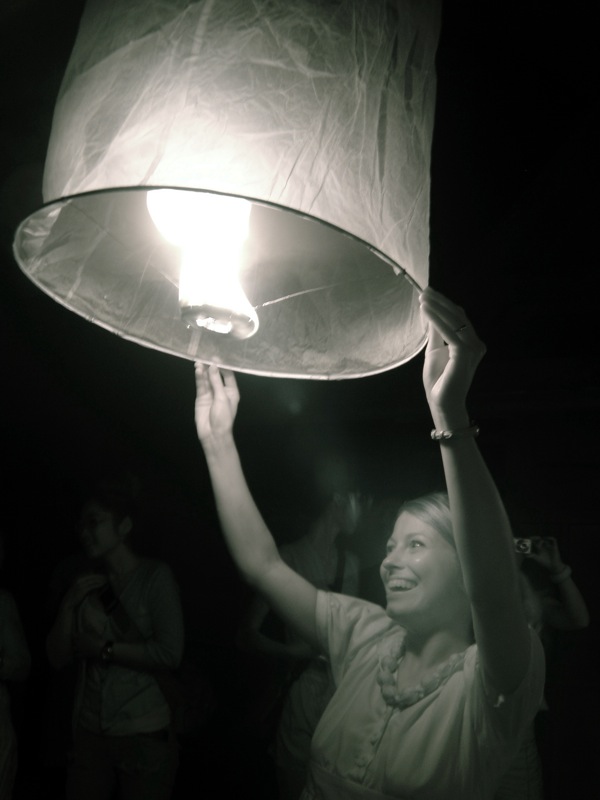 The highlight of the evening was setting off hot air balloons over the pond.
The highlight of the evening was setting off hot air balloons over the pond.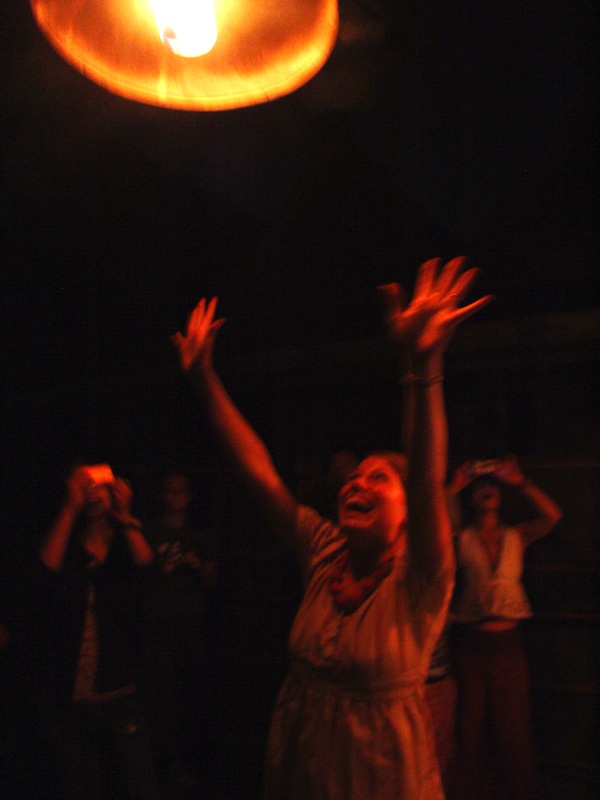 A couple got caught in a tree, but thankfully they worked their way out before catching anything on fire.
A couple got caught in a tree, but thankfully they worked their way out before catching anything on fire.These lovely ladies (oops, laddies i mean) were probably a close second or third after the balloons and bugs. It kind of surprised us how common transvestitism is here in Thailand, but it has none of the stigma associated with it in the states. There's matriarchy for you. Everybody just gets along.
